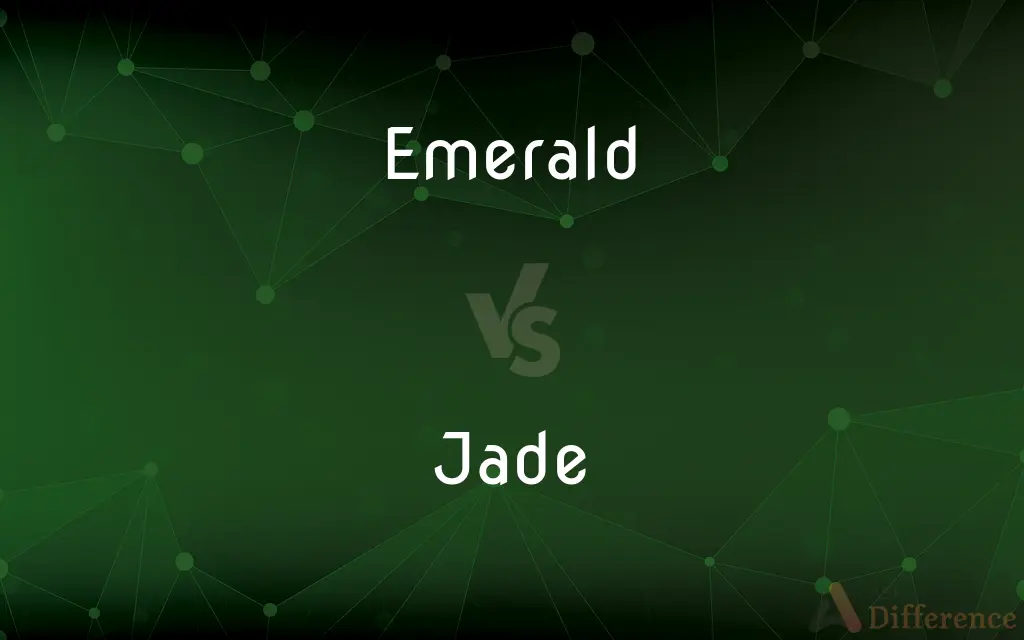Emerald vs. Jade — What's the Difference?
By Tayyaba Rehman — Updated on September 8, 2023
Emerald is a green gemstone primarily composed of beryl and enriched with chromium, while Jade is either of two distinct minerals jadeite or nephrite that are generally green but can come in multiple colors.

Difference Between Emerald and Jade
Table of Contents
ADVERTISEMENT
Key Differences
Emerald is a precious gemstone known for its vibrant green hue, achieved through traces of chromium and sometimes vanadium. Jade, on the other hand, is often green but can also be found in shades like white, pink, and black, depending on its mineral composition.
Emerald belongs to the beryl family of minerals, making it structurally different from Jade, which is categorized as either jadeite or nephrite. The composition of Emerald lends it a glassy luster, while Jade generally has a more waxy or greasy appearance, depending on the specific type.
Both Emerald and Jade have historical significance, but they originate from different geographical regions. Emeralds are often sourced from countries like Colombia and Zambia, while Jade is predominantly found in East Asian countries such as Myanmar, China, and New Zealand.
Emeralds are generally more brittle and are scored between 7.5 and 8 on the Mohs scale of hardness. Jade, particularly jadeite, can be much tougher, scoring between 6 and 7 on the Mohs scale but excelling in terms of resistance to breaking.
Comparison Chart
Composition
Made of beryl
Made of jadeite or nephrite
ADVERTISEMENT
Color Range
Primarily green
Green, white, pink, black, etc.
Origin
Colombia, Zambia, etc.
Myanmar, China, New Zealand, etc.
Hardness
7.5-8 on Mohs scale
6-7 on Mohs scale
Luster
Glassy
Waxy or greasy
Compare with Definitions
Emerald
Emerald is a green, transparent variety of beryl used as a gemstone.
She wore a stunning necklace with an emerald pendant.
Jade
Jade is a durable ornamental stone, either jadeite or nephrite, often green in color.
He gifted her a jade bracelet for luck.
Emerald
Emerald is a mineral enriched with chromium and sometimes vanadium to achieve its color.
The presence of chromium gives the emerald its unique hue.
Jade
Jade is an ornamental mineral predominantly sourced from East Asia.
This jade statue was crafted in China.
Emerald
Emerald is a gem often sourced from Colombia and Zambia.
This emerald came from a reputable mine in Zambia.
Jade
Jade is a gemstone known for its toughness and varying colors.
The jade carvings were intricate and beautiful.
Emerald
Emerald is a precious stone known for its vibrant green color.
The emerald in the ring was breathtaking.
Jade
Jade can be either of two minerals, jadeite or nephrite, used for carving and jewelry.
This is a rare form of jadeite jade.
Emerald
Emerald is a gemstone associated with qualities like fertility and rebirth.
The emerald symbolizes renewal and growth.
Jade
Jade is a stone often associated with purity and serenity in various cultures.
The jade Buddha is considered a symbol of purity.
Emerald
Emerald is a gemstone and a variety of the mineral beryl (Be3Al2(SiO3)6) colored green by trace amounts of chromium and/or sometimes vanadium. Beryl has a hardness of 7.5–8 on the Mohs scale.
Jade
Jade is an ornamental mineral, mostly known for its green varieties, though it appears naturally in other colors as well, notably yellow and white. Jade can refer to either of two different silicate minerals: nephrite (a silicate of calcium and magnesium in the amphibole group of minerals), or jadeite (a silicate of sodium and aluminium in the pyroxene group of minerals).
Emerald
A bright green precious stone consisting of a chromium-rich variety of beryl
An emerald necklace
Jade
A hard, typically green stone used for ornaments and implements and consisting of the minerals jadeite or nephrite
A jade figurine
Emerald
A bright green colour
The sea glistened in shades of emerald and jade
Jade
A bad-tempered or disreputable woman.
Emerald
A slender-bodied green moth, the colour of which tends to fade as the moth ages.
Jade
An old or worn-out horse.
Emerald
A hawker dragonfly with a metallic green body.
Jade
Either of two distinct minerals, nephrite and jadeite, that are generally pale green or white and are used mainly as gemstones or in carving.
Emerald
A small hummingbird with bright metallic green plumage and darker wings and tail, found mainly in the area of the Caribbean and Central America.
Jade
A carving made of jade.
Emerald
Bright green in colour
Beyond the airport lay emerald hills
Jade
Jade green.
Emerald
A brilliant green to grass-green transparent variety of beryl, used as a gemstone.
Jade
A broken-down or useless horse; a nag.
Emerald
A strong yellowish green.
Jade
A woman regarded as promiscuous.
Emerald
Of a strong yellowish green.
Jade
An outgoing, often flirtatious girl.
Emerald
Any of various green gemstones, especially a green transparent form of beryl, highly valued as a precious stone.
Jade
A semiprecious stone, either nephrite or jadeite, generally green or white in color, often used for carving figurines.
Emerald
Emerald green, a colour.
Jade
A bright shade of slightly bluish or greyish green, typical of polished jade stones.
Jade green
Emerald
Any hummingbird in the genera Chlorostilbon and Elvira; and some in the genus Amazilia
Jade
A succulent plant, Crassula ovata.
Emerald
(entomology) Any of various species of dragonfly of the family Corduliidae.
Jade
A horse too old to be put to work.
Emerald
A size of type between nonpareil and minion, standardized as 6½-point.
Jade
A bad-tempered or disreputable woman.
Emerald
Of a rich green colour.
Jade
Of a grayish shade of green, typical of jade stones.
Emerald
To ornament with, or as if with, emeralds; to make green.
Jade
To fatigue, tire, or weary (someone or something).
Emerald
A precious stone of a rich green color, a variety of beryl. See Beryl.
Jade
(obsolete) To treat (someone or something) like a jade; to spurn.
Emerald
A kind of type, in size between minion and nonpare l. It is used by English printers.
Jade
(obsolete) To make (someone or something) contemptible and ridiculous.
Emerald
Of a rich green color, like that of the emerald.
Jade
A stone, commonly of a pale to dark green color but sometimes whitish. It is very hard and compact, capable of fine polish, and is used for ornamental purposes and for implements, esp. in Eastern countries and among many early peoples.
Emerald
A green transparent form of beryl; highly valued as a gemstone
Jade
A color resembling that of jade{1}; it varies from yellowish-green to bluish-green.
Emerald
A transparent piece of emerald that has been cut and polished and is valued as a precious gem
Jade
A mean or tired horse; a worthless nag.
Tired as a jade in overloaden cart.
Emerald
The green color of an emerald
Jade
A disreputable or vicious woman; a wench; a quean; also, sometimes, a worthless man.
She shines the first of battered jades.
Jade
A young woman; - generally so called in irony or slight contempt.
A souple jade she was, and strang.
Jade
To treat like a jade; to spurn.
Jade
To make ridiculous and contemptible.
I do now fool myself, to let imagination jade me.
Jade
To exhaust by overdriving or long-continued labor of any kind; to tire, make dull, or wear out by severe or tedious tasks; to harass.
The mind, once jaded by an attempt above its power, . . . checks at any vigorous undertaking ever after.
Jade
To become weary; to lose spirit.
They . . . fail, and jade, and tire in the prosecution.
Jade
A semiprecious gemstone that takes a high polish; is usually green but sometimes whitish; consists of jadeite or nephrite
Jade
A woman adulterer
Jade
A light green color varying from bluish green to yellowish green
Jade
An old or over-worked horse
Jade
Get tired of something or somebody
Jade
Exhaust or tire through overuse or great strain or stress;
We wore ourselves out on this hike
Jade
Similar to the color of jade; especially varying from bluish green to yellowish green
Common Curiosities
How do Emerald and Jade differ in color?
Emerald is primarily green, while Jade can be green, white, pink, black, etc.
Where is Jade usually found?
Jade is usually found in East Asia, especially Myanmar, China, and New Zealand.
What is Jade made of?
Jade can be made of either jadeite or nephrite.
Where is Emerald usually found?
Emerald is usually found in Colombia and Zambia.
How hard is Jade?
Jade scores between 6 and 7 on the Mohs scale.
What type of luster does Emerald have?
Emerald has a glassy luster.
What type of luster does Jade have?
Jade has a waxy or greasy luster.
What is Emerald made of?
Emerald is made of beryl enriched with chromium and sometimes vanadium.
Can you find Emerald and Jade in the U.S.?
While not as common, some forms of Emerald and Jade can be found in the U.S.
How hard is an Emerald?
Emeralds score between 7.5 and 8 on the Mohs scale.
Is Emerald considered luckier than Jade in any culture?
Both stones are considered lucky in various cultures, but Jade is particularly associated with good fortune in East Asian cultures.
Is Emerald more expensive than Jade?
Generally, high-quality emeralds are more expensive than most forms of jade.
What is Emerald commonly used for?
Emerald is commonly used in jewelry.
What is Jade commonly used for?
Jade is commonly used in jewelry and ornamental carvings.
How are Emerald and Jade commonly cut?
Emeralds are often cut into faceted shapes, while Jade is more commonly cut into cabochons or carved.
Share Your Discovery

Previous Comparison
Polyester vs. Microfiber
Next Comparison
Perinatal vs. PrenatalAuthor Spotlight
Written by
Tayyaba RehmanTayyaba Rehman is a distinguished writer, currently serving as a primary contributor to askdifference.com. As a researcher in semantics and etymology, Tayyaba's passion for the complexity of languages and their distinctions has found a perfect home on the platform. Tayyaba delves into the intricacies of language, distinguishing between commonly confused words and phrases, thereby providing clarity for readers worldwide.
















































